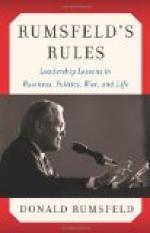not to neglect of military counsels, but to the adoption
of such counsels, contrary to the more far-seeing
judgment of the civil side.” That is a
condemnation of the civilian Minister and of the Cabinet,
for no man in charge of the Nation’s affairs
ought to take the responsibility for a decision of
the soundness of which he is not convinced. If
Lord Lansdowne disagreed with Lord Wolseley and was
not prepared to ask for that officer’s retirement,
why did he not himself retire rather than make himself
responsible for measures which he thought wrong or
mistaken? These are not personal criticisms or
attacks. Lord Wolseley and Lord Lansdowne have
both of them in the past rendered splendid services
to the Nation. But the Empire is at stake, and
a writer’s duty is to set forth and apply the
principles which he believes to be sound, without
being a respecter of persons yet with that respect
for every man, especially for every public man, which
is the best tradition of our National life. What
at the present moment ought not to be tolerated is
what Lord Ernest Hamilton suggests, an attack upon
the generals at the front, to save the War Office
or the Cabinet; and what is needed is that the Ministers
should choose a war adviser who can convince them,
even though to find him they have to pass over a hundred
generals and select a colonel, a captain, or a crammer.
THE STRATEGY OF THE WAR
January 11th, 1900
The arrival of Lord Roberts at Cape Town announces
the approaching beginning of a new chapter in the
war, though the second chapter is not yet quite finished.
The first chapter was the campaign of Sir George White
with sixteen thousand men against the principal Boer
army. It ended with Sir George White’s
being surrounded in Ladysmith and there locked up.
The second chapter began with the arrival of.
Sir Redvers Buller at Cape Town. It may be reviewed
under two headings: the conception and the execution
of the operations. When Sir Redvers Buller reached
the Cape, the force which he was expecting, and of
which he had the control, consisted altogether of
nearly sixty thousand regular troops, besides Cape
and colonial troops. There was an Army Corps,
thirty-five thousand, a cavalry division, five thousand,
troops for the defence of communications, ten thousand,
and troops at the Cape amounting to eight thousand,
some of whom were at Mafeking and Kimberley. After
deducting fourteen thousand men for communications
and garrisons at the Cape, the commander had at his
disposal for use in the field about forty-four thousand
regular troops arranged as a cavalry brigade, seven
brigades of infantry, and corps troops.




